The Role of Low Intrinsic Emittance in Modern Photoinjector Brightness
Photocathode improvements are one of the directions the CBB is exploring to increase the brightness of electron sources. However, non-linear forces from space charge or optical elements can cause the beam to lose brightness on its way from the source to the point where it is used. In systems where this happens, the full benefit of newly developed photocathode technologies may not be realized. In this work, we show that for three specific photoinjector configurations (which are representative of commonly used real-world systems), those brightness degrading effects are small enough that photocathode research remains a viable path to brighter beams.
Applications and relation to CBB Goals:
Our results pave the way for photocathode research to translate into higher usable brightness for realistic photoinjector configurations. This is important for brightness limited accelerator applications such as single shot ultrafast electron diffraction and x-ray free electron lasers.
Reference:
C. M. Pierce, M. B. Andorf, E. Lu, C. Gulliford, I. V. Bazarov, J. M. Maxson, M. Gordon, Y.-K. Kim, N. P. Norvell, B. M. Dunham, and T. O. Raubenheimer, “Low intrinsic emittance in modern photoinjector brightness,” Phys. Rev. Accel. Beams, vol. 23, no. 7, p. 070101, Jul. 2020, doi: 10.1103/PhysRevAccelBeams.23.070101. Available [Online] https://arxiv.org/abs/2004.08034

